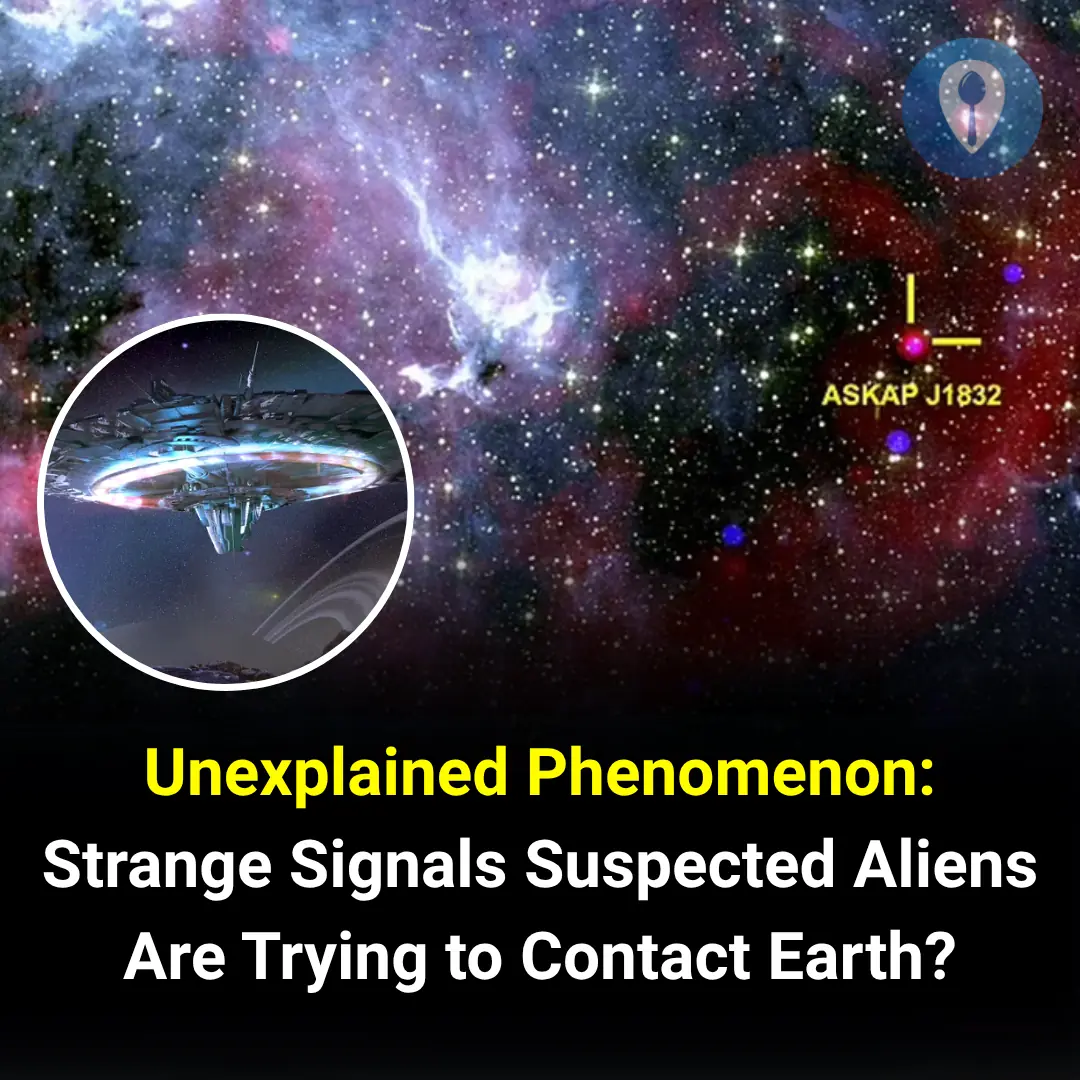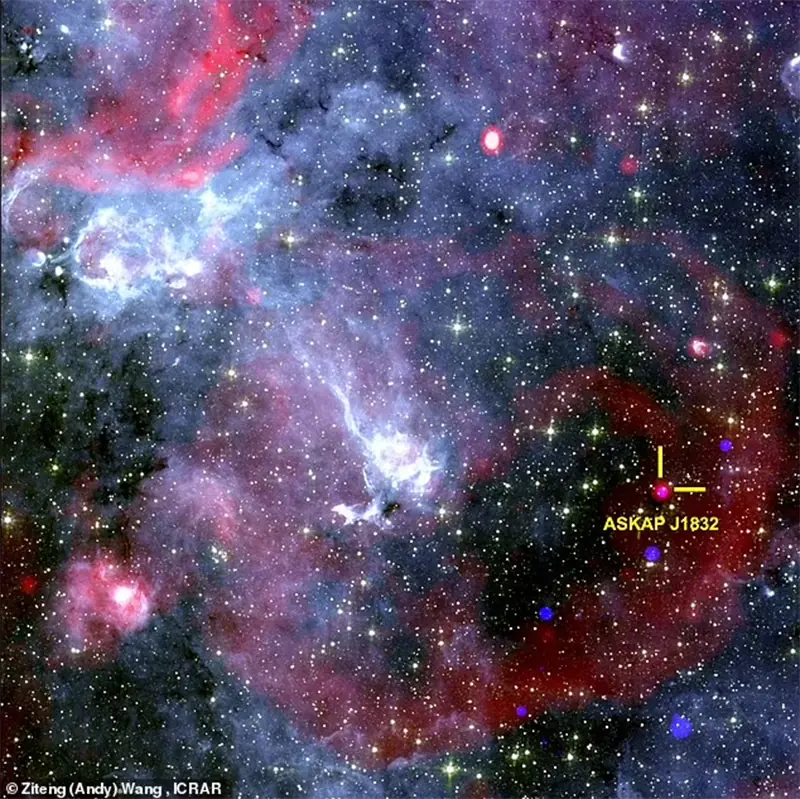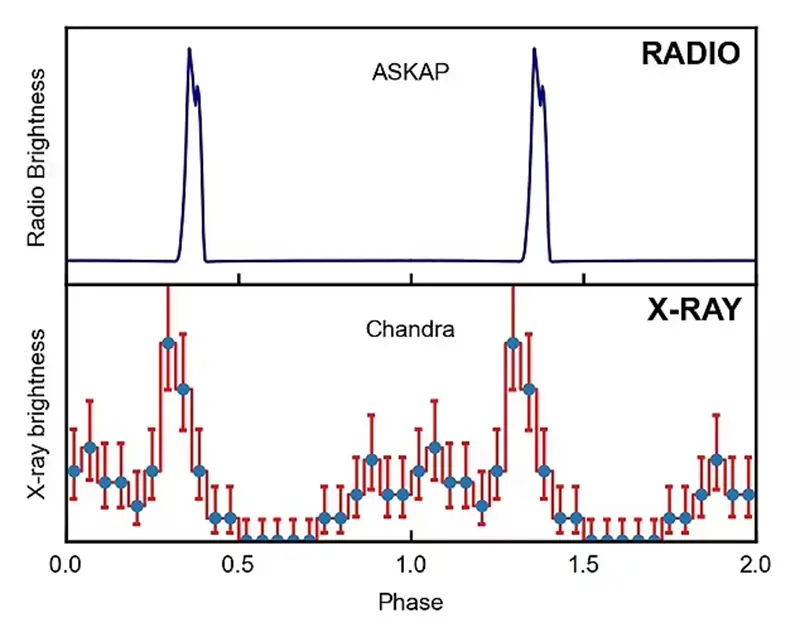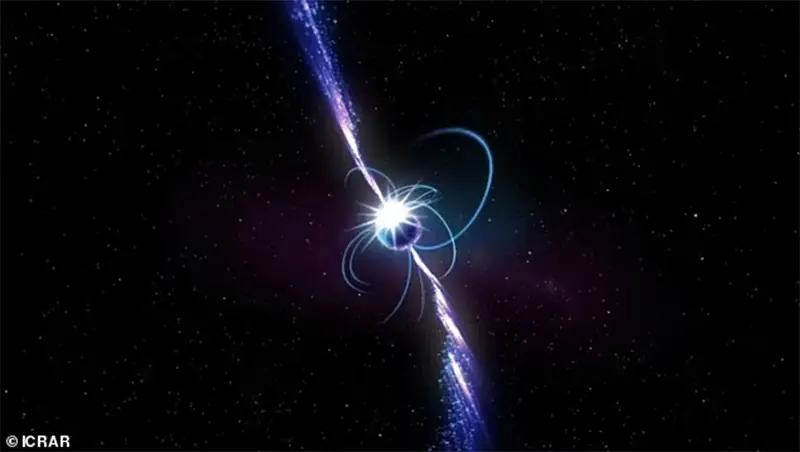
Unexplained Phenomenon: Strange Signals Suspected Aliens Are Trying to Contact Earth?

In a dark region of space, approximately 14,700 light-years from Earth, a mysterious object is doing something entirely unexpected.
A cosmic entity known as ASKAP J1832-0911 is emitting bursts of radio waves and X-rays simultaneously, lasting two minutes every 44 minutes.
This marks the first time such an object—classified as a long-period transient (LPT)—has been observed emitting X-rays.
Currently, there is no clear explanation for the origin of these signals, or why they turn “on” and “off” in such a regular, prolonged, and strange pattern.
Experts admit that even the best existing hypotheses cannot account for this phenomenon, which challenges our current understanding of physics.
They believe ASKAP J1832-0911 could be a completely new type of astronomical object never seen before.
This cosmic phenomenon is located deep within the galactic plane, a region dense with stars, gas, and dust.
Dr. Andy Wang of Curtin University (Australia) stated:
"This object is unlike anything we’ve ever seen before."
His team discovered the phenomenon using the ASKAP radio telescope situated on the land of the Wajarri people in Australia, operated by Australia’s national science agency, CSIRO.
They matched the radio signals with X-ray bursts captured by NASA’s Chandra X-ray Observatory, which happened to be observing the same patch of sky at the time.
Dr. Wang said:
“Finding that ASKAP J1832-0911 emits X-rays is like finding a needle in a haystack. ASKAP has a wide field of view, while Chandra only observes a tiny portion of the night sky. It was pure luck that Chandra was looking at exactly the same region at that moment.”
LPTs, which are objects that emit radio bursts minutes or even hours apart, were first discovered in 2022. So far, astronomers worldwide have recorded only 10 such objects.
“ASKAP J1832-0911 might be a magnetar—the core of a dead star with an extremely strong magnetic field—or possibly a binary star system where one star is a magnetic white dwarf,” Dr. Wang explained.
According to Dr. Wang, this discovery could hint at an entirely new type of physics or revised models of stellar evolution.
“What makes it even more intriguing is that the X-ray emission also follows the exact same 44-minute cycle. This object doesn’t resemble any known source in our galaxy, so we need more observations to figure out what exactly is going on,” he added.
This discovery also narrows down the possible explanations. Since X-rays are far more energetic than radio waves, any theory must account for both forms of radiation. This is a critical clue, especially as the true nature of these signals remains a cosmic mystery.
So far, ASKAP J1832-0911 is the only known LPT to emit X-rays.
The X-ray pulses provide direct evidence of the object’s dense nature, while the radio waves indicate the presence of a structured, organized magnetic field, according to researchers.
Professor Nanda Rea, co-author from the Institute of Space Sciences and the Catalan Institute for Space Studies (Spain), noted:
“The discovery of such an object suggests that many more may exist out there.”
“The detection of periodic X-ray emissions opens new directions for studying their mysterious nature,” Rea added.
In 1974, astronomers sent a radio message containing basic information about humanity and Earth using the Arecibo telescope in Puerto Rico, hoping to contact extraterrestrial intelligence.
This message, later known as the “Arecibo Message,” was aimed at the M13 star cluster, located about 21,000 light-years from Earth.
WHAT IS A NEUTRON STAR?
A neutron star is the collapsed core of a dead star.
When a massive star reaches the end of its life cycle, its core collapses, and its outer layers are expelled into space.
What remains is an incredibly dense object known as a neutron star—containing more mass than the Sun but packed into an area the size of a city.
A typical neutron star has about 500,000 times the mass of Earth, yet is only around 20 kilometers wide.
Just a teaspoon of its matter could weigh as much as Mount Everest.
These stars are extremely hot (millions of degrees), emit intense radiation, and possess immensely powerful magnetic fields.
According to Professor Patrick Sutton from Cardiff University, this is one of the most extreme environments in the known universe.
The core of dense objects like neutron stars plays a key role in unlocking the origins of heavy elements in the universe.
Souces: vietnamnet
News in the same category


Sick pork can be used as fish feed, just "cook it and it's done": What do experts say?

Should you drink water that has been left overnight and uncovered?

What the small hole on a kn.ife is for?

Think Salmon Is the King of Omega-3? Think Again—This Humble Supermarket Fish Takes the Crown

Even if the Noodle Seller Denies It, This 5-Second Trick Will Reveal If Borax Is in Your Noodles

5 foods that are better off stored outside the fridge

Dirty Grout Between Bathroom Tiles? These 5 Simple Methods Will Restore the Shine With Minimal Effort

No More Watery or Dry Meat – Use This Drop Method to Defrost Fast and Keep It Fresh

Why smart people always do that?

Stop Charging Your Battery to Full — This Proven Method Protects It from Damage and Keeps It Running for a Decade

It's Not Your Air Conditioner This Hidden 'Power Thief' Is Draining Your Wallet

How Long Can Pork Be Kept in the Fridge Before It Becomes Unsafe to Eat? Expert Warns: After This Time, It’s Full of Parasites

Persistent Throat Tightness Mistaken for a Stomach Issue — Woman Accidentally Discovers She Has Thyroid Cancer

6 Household Items That Seem Harmless but Secretly Block Prosperity and Disrupt Your Life

A familiar type of water contains 240,000 microplastic particles: It will increase 2-4 times if you do this

5 "Negative Energy" Plants to Avoid Planting in Front of Your House: They May Bring Poverty for Generations

Two Types of Vegetables That Are Unlikely to "Absorb" Pesticides — The Top One Is Surprisingly Unknown to Many

These 3 Meats Can Harbor Parasites if Not Cleaned Thoroughly
News Post

Easy Growing Clove: From Seed to Spice

No Matter How Hot It Gets, Avoid These Dange.rous Habits

"King of herbs" is good for the heart and breaks down kidney stones

Check your eyes now! If you have one of these 4 characteristics, you may have diabetes.

Sick pork can be used as fish feed, just "cook it and it's done": What do experts say?

Family of 4 brothers all have stomach can.cer, doctor shakes head: 2 "fatal" common points that many people have

How to Identify Safe, Clean Pork in Just 1 Minute – Anyone Can Do It

Check Your Skin for Liver Problems: If You See These 3 Colors—Red, Black, or Yellow—See a Doctor Before It’s Too Late!

How to Grow Blackberries at Home in Pots

Unlock the Power of Carrot Juice: A Natural Boost for Thriving Plants

Should you drink water that has been left overnight and uncovered?

Boost Your Tomato Growth with Onion Peels: Nature’s Secret Fertilizer!

Trimming Lavender: Tips & Tricks from the Expert

Why should you put a lemon at the head of your bed?

Honey is good but not for everyone

Growing Tomato Plant From Tomato Slice Time Lapse

How To Grow Rosemary From Seed Or Cuttings – Everything You Need To Know

Tips to prevent clothes from tangling and wrinkling in the washing machine

Rice Grains Unleashed: Supercharge Your Plants with Natural Strength and Vitality
